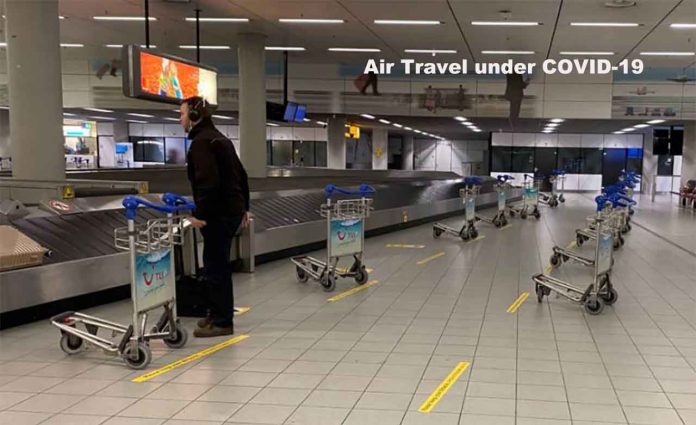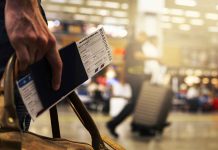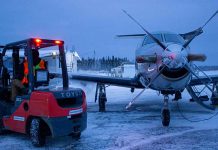
To be reunited with his family, our reporter embarked on a two-day air journey from Tbilisi to London. This is his experience.
By Umberto Bacchi
TBILISI (Thomson Reuters Foundation) – My two-day journey from Tbilisi to London to be reunited with my family was like none I had embarked on before.
As cities around the world start to emerge from coronavirus lockdowns, international travel restrictions meant I hadn’t seen my wife and one-year-old daughter in more than two months.
I was in our one-bedroom flat in Tbilisi, Georgia, while they were more than 6,000 miles away visiting family in Canada, and suddenly unable to return home.
Our family’s multiple nationalities – I am Italian, my wife is Canadian-Georgian and our daughter is British – were of little help as countries started to shut their borders to contain the pandemic.
After about 10 weeks of waiting and repeated calls to airlines, hotels, foreign ministries and border agencies in five different countries, we finally devised a plan.
We would meet halfway in London – as the UK had yet to put any restriction on incoming travellers – fly to Italy together and stay there until we could get a flight back home to Tbilisi.
Having written about urban issues for more than a year, I was about to find out firsthand what flying from one city to another now looked like.
TBILISI TO AMSTERDAM
Ready to embark on my first government-operated flight to Amsterdam on the way to London, I arrived to a desolate departure lounge in Tbilisi: cafes closed, shops shut and vending machines switched off.
The journey was about to get stranger.
After Georgian Airways staff at the check-in desk quizzed me at length about my travel plans and gave me my boarding card, I made my way to security.
The usual queues had disappeared and with them the requirement to pull your laptop out of hand luggage before placing it on the conveyor belt. For reasons that escape me, the same was true in Amsterdam.
The flight was half-full and somehow much busier than I expected. My fellow travellers included the crew of a cargo ship docked in the Netherlands and an Orthodox priest.
Nearly all of the six-seat rows – three per side – were occupied by one to four passengers.
The airline had ensured that the middle seats were left empty which meant travellers had about 45 centimetres of space between one another.
Most passengers wore face masks and I was impressed to note the crew were sporting full-body protective blue vests with yellow gloves, a clear plastic face visor and a white mask.
“Feels like I’m flying to Mars,” I texted my editor before take-off.

When we landed in Amsterdam’s Schiphol airport an announcement told us to “maintain at least 1.5 metres of distance from other travellers and airport staff”.
With almost no one in sight, that proved fairly easy up to passport control.
Yellow floor tiles were emblazoned with written reminders of distancing rules to show queuing passengers where they could safely stand. They were largely ignored.
People particularly struggled to keep their distance on hairpin turns, as the queue line sashayed towards the border officers’ booths.
When my turn came, I walked towards the assigned border officer with some disquiet. I had been assured by Dutch authorities that as a European Union national I would be allowed to pass through the Netherlands on route to the UK. But could I have missed something?
Around me, distressed flyers were falling foul of constantly evolving – and sometimes conflicting – travel restrictions.
A blonde woman who had not been allowed to enter the Netherlands was crying on the phone. Two despondent men who had suffered a similar fate sat on a nearby bench outside the immigration office.
The officer took a look at my passport, smiled and waved me through without a word.
The airport was largely empty but shops and restaurants were open.
Two rows of trolleys had been positioned next to the baggage carousel like a starting grid, inviting passengers to wait for their luggage at distance.
Yet as soon as luggage arrived, people crowded around the carousel, as they did before the pandemic.
My flight to London wasn’t due to take off until the next day, so I spent the night in a hotel on the outskirts of the city.
The next morning I returned to the airport an hour before my flight, only to find a massive line at the check-in desk. I was going to miss my flight.
It soon became clear we were all in the same boat.
When an airline employee emerged from behind a large plastic curtain to ask who had a flight leaving within the next 45 minutes, almost the entire queue raised their hands.
The computer system had crashed, flights would be delayed but we would all make it on board, she explained. And so it was.
At the gate, some benches had been wrapped in red and white tape to prevent waiting passengers from sitting too close to each other.
No such rule applied onboard. The flight was packed.
The airline, KLM, required everyone on board to wear a face mask. A snack and a paper bag were laid on every seat. No catering trolleys would pass.
As the aircraft commenced its descent into London, an in-flight announcement advised passengers experiencing any COVID-19 symptoms to make themselves known to the cabin crew or report to health authorities on arrival.
At Heathrow airport things were pretty similar to Schiphol, although the required social distance here had gone up from 1.5 to 2 meters.
I scanned my passport at the e-gates, picked up my luggage and walked out into the British sunshine.
A few days later, I returned to the airport to pick up my daughter and kiss my wife. We may not be home yet but we are together.
(Reporting by Umberto Bacchi @UmbertoBacchi, Editing by Zoe Tabary. Credit the Thomson Reuters Foundation)







